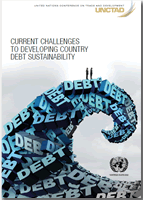Ten years after the global financial crisis, UNCTAD estimates that the ratio of global debt to gross domestic product (GDP) was a third higher at the beginning of 2018 than at the start of the crisis in 2007/2008, and roughly four times global GDP.
While rising indebtedness is a general and global phenomenon, it is the debt levels of developing countries that have highlighted future debt sustainability vulnerabilities.
In this paper, it is argued that it is only in the context of the conditions and mechanisms created by the global financial system that the increasing indebtedness of developing countries can be understood.
While it is generally accepted that the provision of unprecedented levels of liquidity by advanced economies to counter weakness and instability in their economies following the global financial crisis of 2007–2008 sowed the seeds for the next crisis by making portfolio capital flows to developing countries more attractive; the global financial system that created the crisis remains in place and continues to exert its influence over debt sustainability in developing countries.
The report is divided into five sections:
Section I provides the point of departure for understanding the debt sustainability challenges of developing countries.
Section II examines the debt indicators for 145 developing and transitional countries on a regional basis. The data are limited in scope but provide a useful point of departure for forming a picture of debt at the regional level. More specific data for emerging markets as a subcategory of developing countries show increasing exposure of emerging markets to spillover debt from advanced countries. Financialization has not delivered on its promises of growth and, in the context of persistent downward pressure on aggregate demand, income and employment, together with systemic financial fragility and recurrent instability, a new development agenda must be found.
Section III introduces elements of a balanced growth strategy and section IV contains discussion of the financial elements that would facilitate such a strategy. In the absence of international commitment to reform the global financial system, second best approaches to pre-empt and circumvent its influence on developing countries must be found.
Section IV discussed a number of such approaches, including the development of regional and interregional monetary and financial cooperation and an invigorated role for development banks in local development.
Section V consists of a brief conclusion.

